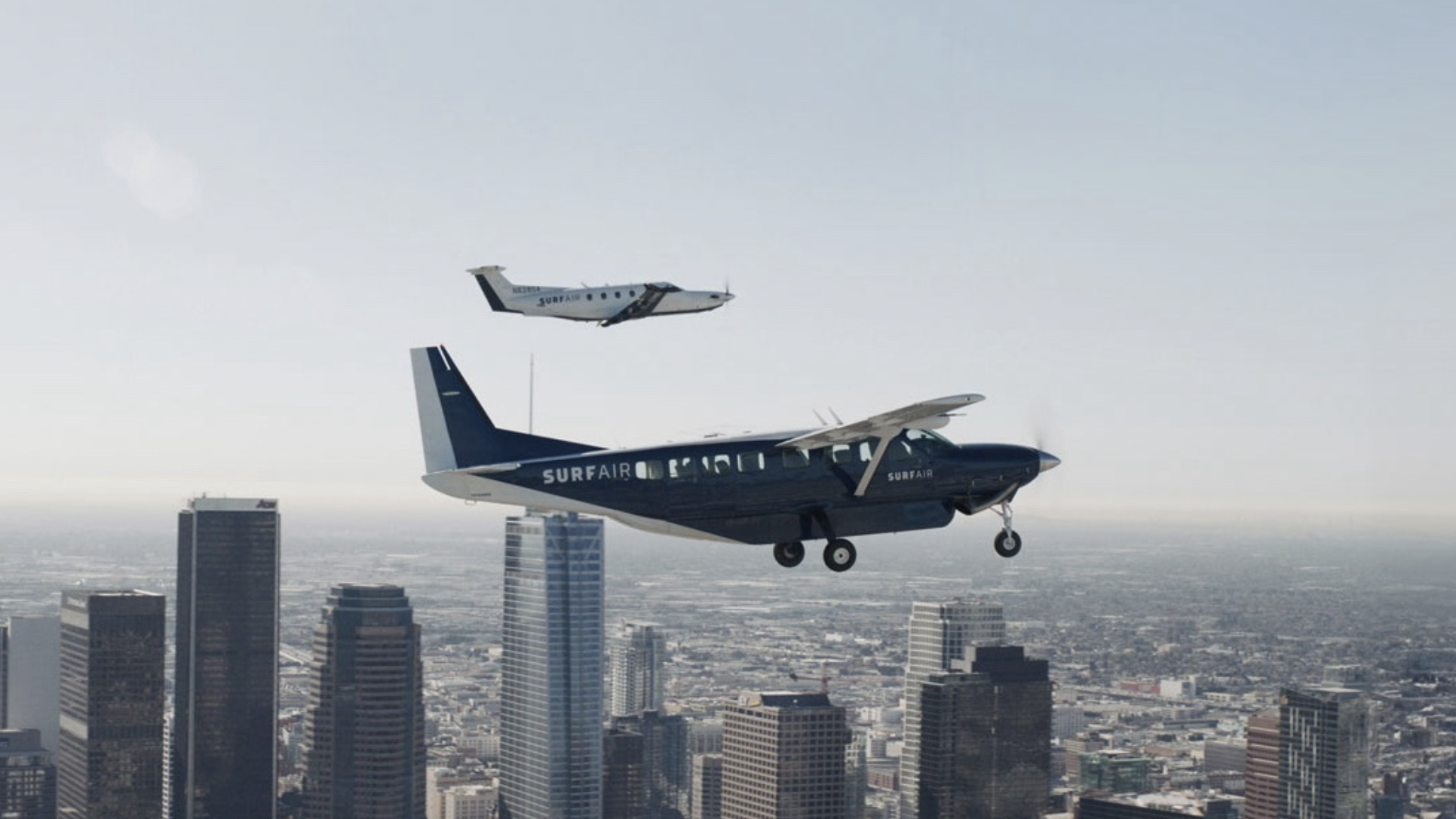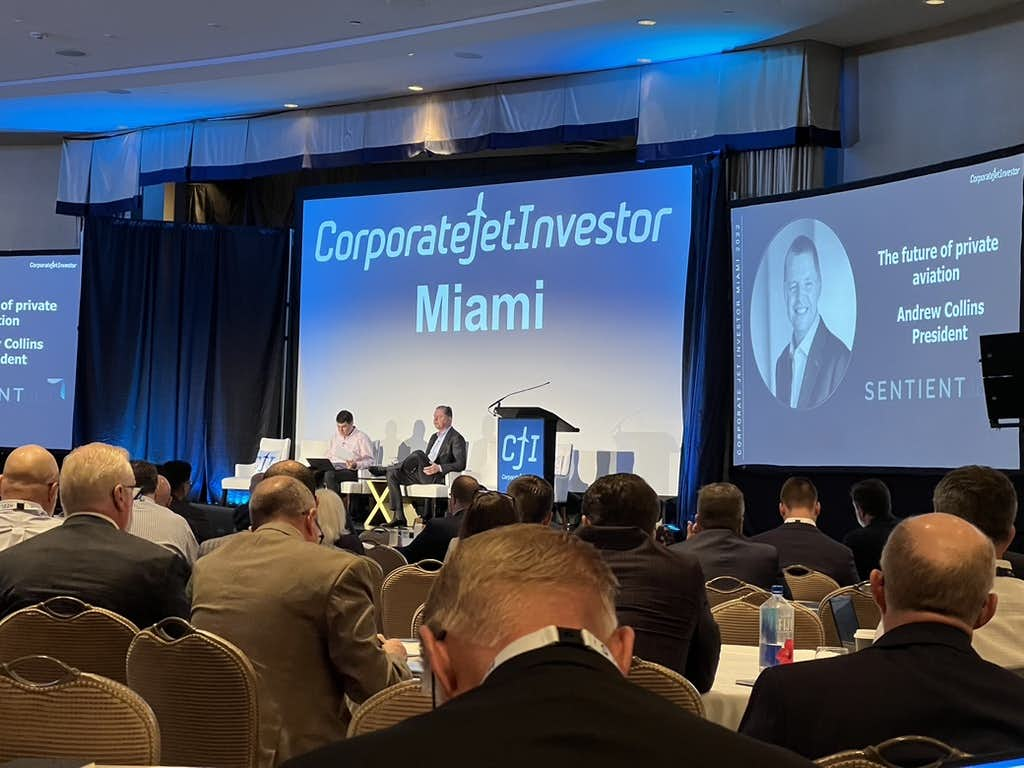

Sentient Jet racked up $40 million in sales last month, a combination of new customers and renewals. It’s a pace that indicates demand to fly privately will likely remain high. It also indicates the company that invented the jet card in 1999 has navigated the past year’s storms.
Speaking at the annual Corporate Jet Investor conference held last week in Miami, Sentient’s President & CEO Andrew Collins says, most importantly, operations are again running smoothly. That’s in large part based on changes to the rule set.
Looking to the year ahead, there is an IPO in the works. Collins will serve as Co-CEO of Flexjet, Inc. (alongside Flexjet brand CEO Mike Silvestro), the new name for Directional’s OneSky Flight unit flight, which is planning a SPAC merger.
It also means a return to more innovation, particularly around technology.
An example is the instant text booking integration it launched over the Summer. As part of its goal to reduce “friction,” customers can book and confirm flights via secured texts in seconds.
That’s in addition to its app, desktop, email, phone, and even fax. Yes, you can still fax your booking request if that’s how you like it.
However, if there’s time for a deep breath, it’s still worth looking back at what a difference a year makes. “Last year, I thought the conference was a therapy session. We lived through it. We learned a lot from the process,” Collins says.
November 2021 was the early stages of answering that question industry executives never imagined they would have to answer. That was, “Is there such a thing as too much business?”
As demand swamped supply beginning in the Summer of 2021, jet card seller responses ranged the gamut. They went from business as usual to a complete shutdown of sales, including renewals to current customers. Sentient, which bills itself as “a more thoughtful way to fly,” ended up falling somewhere in the middle.
It stopped taking new members from September until January, although it allowed current clients to renew. When it did start accepting new members earlier this year, it was on a limited basis. It also included flying restrictions for the first 60 to 90 days.
It’s now back to the standard fly as soon as you join.
The changes it made – and responses from customers, reflected that for the big established jet card players, there are really two customer bases: Long and loyal clients who have been there for years – and newbies dipping their toes into private aviation for the first time, driven in large part by the Covid pandemic.
Like those of us who are old enough to remember the spiral steps on first-generation 747s leading up to a lounge instead of more seats and hot meals on one-hour flights, private flyers using jet cards for years were accustomed to a marketplace with few changes, including prices.
A look back to 2015 shows the Sentient’s light jet rates for a post-2000 aircraft at $5,580 per hour. Older jets went for $4,993 per hour. As of June 2020, when Sentient had gone to a single light jet product, the hourly rate was $5,480. Similarly, midsize jets went from $7,471 or $6,711 per hour in 2015 to $7,302 per hour five years later.
The lack of meaningful increases was largely the residue of business aviation’s lost decade.
Following the Great Recession, there were more jets than customers. At one point, nearly 20% of all business jets were for sale. It was easy to procure them for charters virtually any place, anytime. There weren’t concerns about getting planes fixed quickly and cost-effectively, and there were plenty of pilots. The result was aircraft owners willing to rent their jets out for a slim margin above direct operating expenses, enough to cover any loan payments.
Since the unit of Directional Aviation’s OneSky doesn’t expire funds, it had around 8,000 customer accounts when demand surged to record levels starting in June 2021.
Up until that time, anywhere in the Continental U.S., members were guaranteed an airplane if they called up to 10 hours before departure. It didn’t matter, from a light jet to a large cabin aircraft.
Fly from Pierre, North Dakota, to Ames, Iowa, or New York to Boston, your choice. Just book at least 10 hours in advance on non-peak days.
The daily minimums for lights and midsize jets were 60 minutes, including taxi time.
Members only pay for their actual flight time plus 12 minutes of taxi time per segment.
So, the expense of repositioning the aircraft before and after customers’ flights is borne by Sentient, as is typical for traditional cards.
That includes a 45-minute hop from Pierre to Ames, a trip that would take seven hours by car.
What’s more, there were only 23 peak days, and they carried just a 5% surcharge.
Oh, and catering – full meals – and deicing were included.
If that rule set seems unbelievable, Collins says the last year has meant transitioning its product to current realities and bringing along customers who had spent a decade enjoying prices and policies that overnight were not sustainable.
What’s more, the new policies and increased prices came in sync with the tangible decline in dependability and service felt across the industry.
While Covid kept Sentient employees working remotely for months, Collins says he could often be found walking around his neighborhood talking to customers on his cell phone.
Private Jet Card Comparisons subscribers who say they have had cancelations, delays, and service letdowns more than doubled from 21% to 44% from Summer 2021 to 2022.
Just over half (51%) say they are considering changing providers. However, Sentient flyers renewed at an 85.3% clip.
One who left returned in a few months, finding the grass wasn’t necessarily greener.
“Where we saw price sensitivity is with legacy customers who came in at a certain price point, and that customer has seen a large jump because they were used to pre-2019. The new customer, who is coming today, is fine,” Collins says.
The reset is now apparently complete.
Even at $8,755 per hour for light jets, including 7.5% FET and current fuel surcharges, its pricing is in the middle of the pack.
While Sentient now adds taxi time to the daily minimums, it still works out to 90 minutes (78+12), including taxi time on light jets, with midsize aircraft at 102 minutes (90+12), better than most.
The callout is now 48 hours, significantly below the industry average of 62 hours.
While others have stripped away international coverage, Sentient kept fixed rates to the Caribbean, Mexico, and Canada intact. There is still only a 10% surcharge. It continues to offer guaranteed fixed rates in Europe.
You still get meals, and since the beginning of 2021, every flight is offset to be both carbon and emissions-neutral. That offsets 300% of carbon emissions to cover the non-CO2 emissions.
It also continues to offer recovery flights without additional charges, something that is being peeled back in other programs.
Maybe the most important change was how Sentient handled its peak days calendar.
The average number of peak days across the more than 250 guaranteed fixed-rate offerings we track has increased from 22.8 days to 53.7 days.
While some companies implemented blackouts and others slotted in anywhere from 90 to 120 peak days, Sentient went from just 23 to 29 peak days.
It did, however, implement a flight cap. On any date when bookings reach 200 flight hours, it reserves the right to stop taking additional bookings.
Put another way, that says Sentient is prepared to fly 73,000 flight hours annually. Since Sentient is a broker – it uses vetted partner operators – its annual flight hours cap would rank as the second-largest Part 135 operator.
Through today, Collins says the cap was only implemented 11 times in 2022.
The net result has been protecting customers who book in advance, which reduced day-of-departure challenges in finding recovery aircraft at the last minute.
It also meant not having to crystal ball future travel patterns, which can no longer be forecast precisely.
Going forward, Collins says the trend is towards large cabin flying and more international travel. Members are also staying longer, something that helps operationally as there isn’t the same weekend travel surge.
The Sentient boss believes that’s a residue of Covid with executives finding they can effectively run their business remotely, so they may head out to their second homes a day earlier or return Tuesday instead of Sunday night or Monday morning.
He is also not embarrassed by the price increases. Customers overwhelmingly want their providers to be profitable, he says, adding, “This industry tends not to be rationale about pricing, thinking, ‘We’ll make it up down the road, or we’ll make it up in volume.’”
He told CJI attendees, “There’s got to be a fair trade between the balance of profitability and service quality. You can’t say, ‘Private aviation is having supply chain issues, and we’re working through it.’ You’re operating in today’s market. Sell in today’s market.”
Having seen other companies come and go, he says members can count on Sentient to be a rational player in the market.
There is instability ahead, according to Collins. “You still have things out there from a model standpoint that don’t work, so for the next 18 to 24 months, more consolidation.”
On digitalization, he also expects advances. “This is an industry ripe for improvement in technology,” he says, however, he doesn’t see any imminent breakthroughs, saying, “It’s a lot harder (than people understand).”